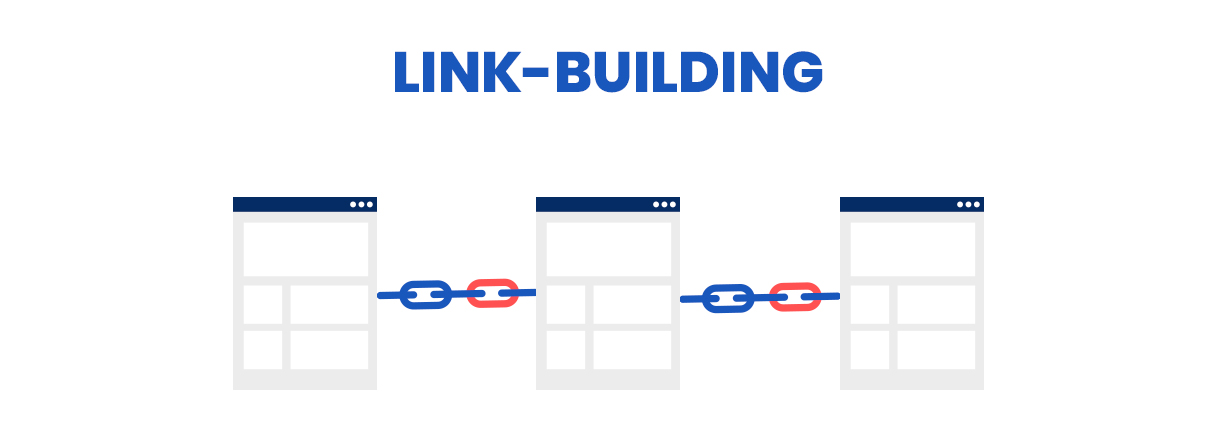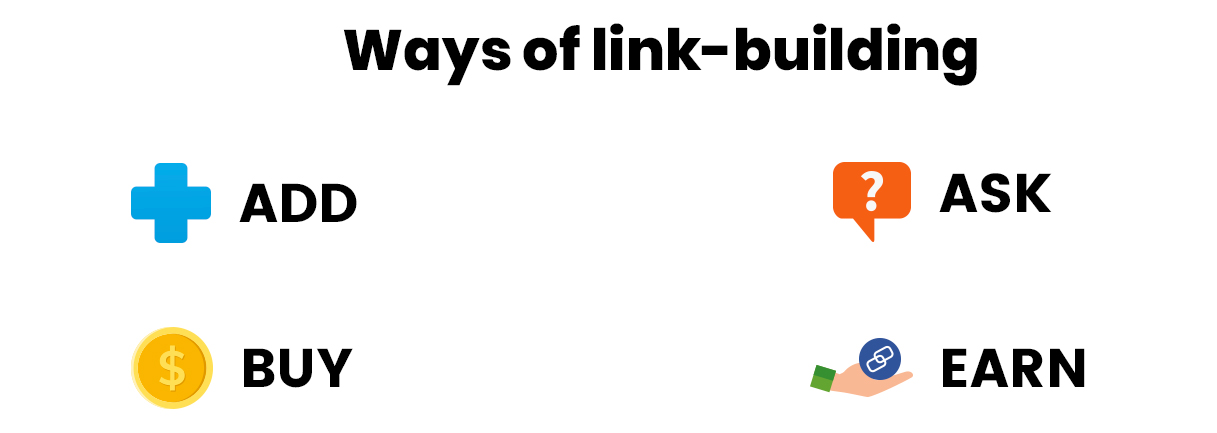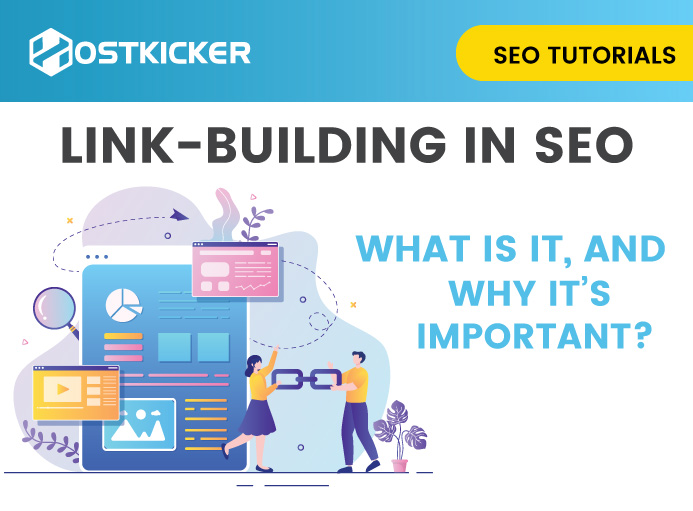Link building in SEO: what is it, and why it’s important?
Are you here to learn what is link building in SEO? You have landed right.
In this write-up, we’ll clarify what link building is in SEO, why it is important, and how to build links for your website effectively.
Link building in SEO is an important off-page SEO tactic used to boost a site’s authority and web traffic. If you are new to SEO, you’ll slowly discover how valuable link building is for SEO.
Earlier, ranking higher on search results was fairly easier. However, with advancements in Google’s algorithm, ranking on SERPs has become quite challenging. There are numerous factors that help search engines to decide the best search results. For instance, your site’s authority, quality, relevancy, etc., are all valuable for achieving higher ranks on SERPs.
Let’s explore link-building in more detail. Let’s get started!
What is Link building in SEO?

Link building in SEO is a way of getting links from other websites to your site to boost your site authority, search visibility, and site traffic. These links are referred to as backlinks and are valuable from an SEO perspective.
Common link-building methods include content marketing, social media marketing, guest posting, broken link building, email outreach, and many more.
What’s the importance of link building in SEO?
In SEO, backlinks act as a vote to signal search engines the credibility and trustworthiness of websites. That’s why backlinks are one of the valuable ranking factors.
To rank a website, Google assesses the authority and trustworthiness of a website which are determined by the Quality and quantity of backlinks.
Therefore, you would need backlinks to boost your authority, achieve higher rankings, and drive traffic referral traffic to your site.
The more quality backlinks your site has, the higher it can rank on search results.
This is why link building in SEO is a valuable strategy for website owners and SEOs.
What are the essentials of link building?
There are two valuable points of consideration while building links:
1. The manner of link building
2. The Quality of links.
1. The manner of link building
Link building in SEO may be done in two ways: the standard way and the inappropriate way. That’s why it’s crucial to understand the benefits and drawbacks of both approaches to follow the best link-building practices.
Links can be obtained naturally by utilizing white hat strategies such as providing link-worthy material, content marketing, guest posting, and so on, or by employing unacceptable black hat tactics such as buying links or obtaining links through manipulative tactics.
We know natural link-building is a time-consuming and demanding process; however, it pays off in the long run.
Make sure you don’t engage in unethical link-building techniques; Google may catch you sooner or later and penalize you for it.
2. The Quality of links.
Another thing to keep in mind during link building is that the Quality and value of each backlink varies. Some links are more valuable than others.
For instance, links from high-authoritative, well-established sites are more valuable than links from low-authoritative or new website sites. This is because links from high-authority sites pass more authority or page rank compared to low-authoritative sites.
Also, Links from sites relevant to your niche are more valuable than links from irrelevant and random sites. For instance, a restaurant website getting a link from another restaurant or hotel website holds more value than a link from an educational website.
Furthermore, try to prioritize Quality over quantity of links. Even though the quantity of links matters, however, the Quality of links can give your site a significant boost.
Google also recommends increasing the number of high-quality links to the sites in order to improve site ranking.
How do you identify a good backlink?

Although no one can explain with certainty what Google looks for in a link to deem it valuable, there are certain significant criteria that may do so.
1. Authority of the site.
Google considers whether the site links to your site are authoritative or not. Links from a high-authority site are more valuable than those from a low-authoritative site.
2. Relevancy of the site.
The relevancy is measured as whether the site is relevant to your niche or not. Links from relevant sites are more valuable compared to non-relevant or random sites.
3. Anchor text of the link.
The link’s anchor text is also important to value a link. Anchor text is the clickable text where the link is placed. It must be natural rather than forced; otherwise will be considered manipulative.
4. Type of link: Follow or Nofollow
Follow link passes link authority, whereas the nofollow link doesn’t. Follow links are more valuable than the nofollow link from an SEO standpoint.
5. Placement of link on the Webpage
The placement of the link also matters for link evaluation. Links at the beginning of the web page are more valuable, links in the body are less valuable, and the ones at the end or footer are least valuable when compared to each other.
Types of Backlinks in SEO

There are various types of backlinks in SEO based on different parameters.
There are mainly two types of backlinks on the basis of their value, whether they add value or not, dofollow and nofollow. In addition to this, there can be a variety of backlinks based on the method they are acquired.
# Backlinks based on their value:
1. Dofollow Links
These are the common backlinks that are valuable from an SEO perspective. When you simply link a website, it’s a do-follow link that signal search engines that the link is organic, the website linking to it is valuable and trustworthy, and the link must pass the page rank. Each backlink without a nofollow tag is a do-follow link.
2. Nofollow Links
On the Contrary, the nofollow links are less valuable from an SEO perspective as they do not pass the page rank. When you put a link to a site with a nofollow tag, you signal search engines to ignore the links or not pass the page rank. You basically use a nofollow link to provide relevant, valuable information on the web without passing the page rank.
The difference between dofollow and nofollow links can’t be seen by the users on the page; however, they are different as they instruct search engines on how to behave with the links, which determines the effect of backlinks on your website SEO.
# Backlinks based on the way they are acquired:
1. Editorial backlinks
These are the links you gain naturally without asking, trading, or paying. The editorial links are placed within the relevant content by website owners when they discover your content valuable and link-worthy. High-quality, informative, valuable, engaging, and original content acquire editorial links over time that are the most worthwhile backlinks.
To get editorial backlinks, try to create evergreen, high-quality, and valuable content that adds value for your users.
2. Guest blogging Backlinks
The backlinks that are acquired from guest blogging are referred to as guest blogging backlinks. Guest blogging is an effective tactic for getting quality backlinks in which you create valuable content for another website in which you editorially include a link to your site.
3. Business Profile Backlinks
The links you include in your business profiles on various platforms, such as your business account on social media (Facebook, LinkedIn, Instagram, etc.), business directories, and listing that point to your website, are called business profile backlinks. These are less valuable from an SEO point of view.
4. Comment backlinks
The backlinks that are included in blog comments naturally to add value to the conversation are the comment backlinks. These backlinks can hurt your SEO if done the wrong way.
Don’t go overboard because Google will consider them spammy if they are used to manipulate search rankings.
5. Forum backlinks
Forums like Quora, Reddit, etc., where you are involved in answering the question to establish yourself as an authority in your niche, can also be used to get backlinks. You can provide links to your site to educate people about something valuable, which can be referred to as forum backlinks.
Similar to comment backlinks, you must not overdo it. Otherwise, this can also be considered spammy and manipulative.
6. PR backlinks
When you or someone publishes a press release concerning your brand, you get backlinks which are referred to as PR backlinks. These are the results of your marketing tactics.
Ways of link building in SEO.
There are mainly three ways to build links in SEO; you can either earn it, request it, or add it manually. Additionally, you can buy links which is not a recommended method.

Let’s see what these are in brief.
1. Earn backlinks
Earning links is the most valuable and effective method of getting links to your site. Although it’s a time-consuming approach, the links you’ll earn will be valuable organic links. Earning links is an approach where you create valuable and link-worthy content and don’t have to ask for links to it. People themselves find your content valuable enough that they link back to it to help their users provide quality information.
To obtain backlinks, you can promote your content on various platforms so that it can reach a targeted audience. This is essential as the more people it can reach, the more will be the chances of earning a link.
Therefore, it’s more beneficial to invest time in creating link-worthy quality content and earning links than making efforts to request or buy links.
2. Request backlinks
Another way of getting links is to ask or request links from other sites. This approach needs more effort and purely depends on the third-party site, but it is effective in getting links.
You have to communicate with other site owners via email and convince them to link you back. Therefore, before reaching out to them, make sure you have valuable content and compelling reasons to ask them for a link.
Think of it this way, why would someone link you back? Only when they are getting something out of it. Right? Thus, make sure you have something valuable for them that can benefit them as well as you.
There are various methods to request a backlink, such as guest blogging, broken link building, link exchange, product/service/site mentions, unlinked mentions, offering them better resources, etc.
If you prefer this approach, make sure the website you are outreaching is authoritative and relevant to your niche. This will help you get a quality backlink.
3. Add links Manually
Manual link building in SEO is another strategy in which you manually add links to create backlinks. Let’s say you go on a website other than yours and place your site’s link there; this is known as manual link building.
For instance, you can add your links to business directories, social platforms, blog comments, forum posts, etc.
Unlike other strategies, this method is entirely in your hands, so you may be even more certain of the result.
Since this link-building approach is the easiest of all, these types of links are less valuable from an SEO standpoint. In Google’s eyes, these are low-quality backlinks that can be regarded as manipulative if not done appropriately and thoughtfully.
However, this doesn’t lower the importance of this approach. Other than getting links, this approach is valuable for multiple reasons, such as increased brand awareness, brand credibility, and trustworthiness, establishing yourself as a topical expert, and bringing in more referral traffic. All these will help you boost your online presence and search reach. You just have to be careful while manually placing backlinks.
4. Buy links – Not recommended
Since we are discussing methods of getting links to the site, there’s another method which is buying links. This is just for your knowledge and is not a recommended approach. In SEO, many people get involved in buying high-quality links to improve their brand authority and to show their credibility, but the results are often the opposite. This is a black hat tactic, and these are bad links that provide you with zero SEO benefits and may even be penalized if Google catches you.
Therefore, make sure you follow only white hat tactics approved by google to build links to your site.
How to do link building in SEO?
There are many effective strategies to build links successfully.
1. Create valuable link-worthy assets.
Creating link-worthy assets such as evergreen, valuable, high-quality content, valuable, attractive infographics, and videos is effective in acquiring quality backlinks. People tend to link valuable content without asking or paying. Also, you can promote your quality content on social platforms to attract more backlinks. This enables you to reach a wider audience, build trust and audience, referral traffic and increase backlinks.
2. Content marketing
Valuable content may not be valued until it reaches its intended audience. Therefore, content marketing is another important step in getting valuable links. It helps you place your content in front of your targeted audience and establish yourself as a topical expert. Once established, your credibility grows, and you might obtain valuable links back to your site.
You can promote your content using social media platforms, advertise it, or outreach to people relevant to your niche, and join forums and community to acquire quality backlinks.
3. Guest blogging
Another valuable and successful method of link-building is guest blogging. In this, you provide valuable content to another website to get backlinks to your site. However, you must carefully do guest blogging. Make sure that the site on which you are guest blogging is authoritative and relevant to your niche, that you deliver valuable and high-quality content that is difficult to refuse, and that you choose a topic that the targeted website has not covered. Furthermore, avoid stuffing many links into your guest post or submitting the same guest post to multiple sites. This is a sure way to acquire high-quality backlinks.
4. Use a competitor’s backlink approach.
Assessing your competitor’s backlink strategy will help you find the backlink gap between you and your competitors. You can discover your competitor’s backlink strategy and sites linking to your competitors but not you.
This data can help you make efforts the right way, reach potential sites and acquire links back to your site to fill the backlink gap.
Tools such as Ahrefs and SEMrush can help you find the backlink gaps effectively to help you improve your backlink profile.
5. Broken link building
Broken link building is another effective tactic that can help you build backlinks. You can discover broken backlinks within your niche and provide them as substitute active links on the web. Make sure your content is link-worthy and provides value to the site, and the backlink is worth getting back to your site.
6. Claim unlinked brand mention
You can acquire backlinks by claiming your brand mentions on the web that are not linking to your site. You can ask for a link to your site by reaching out to the author. If successful, this is the simplest technique to obtain backlinks.
Make your link-building strategy a priority.
Link building in SEO is not a difficult task; it simply needs to be done wisely. Link-building, when done correctly, can increase brand authority, search visibility, and traffic to your site. Relevancy, Quality, quantity, link placement, and other factors are all important when it comes to creating valuable links to your website.
Here we have discussed every aspect related to link building in detail. Hope this has helped you learn link-building in SEO in a better way.
Stay away from black hat link-building tactics that may put your website at risk for a penalty. Follow the successful link-building practices outlined above to promote your trustworthiness to search engines in order to be regarded as authoritative.
Be consistent, stick to the best SEO practices and flourish on the search results.
Good luck with your link-building approach!
